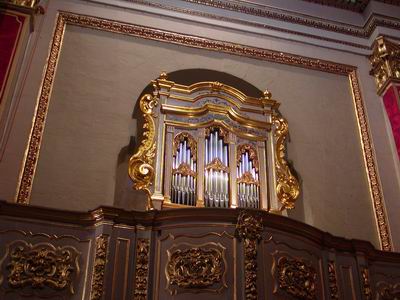 |
|
 |
1778 Positivo by Severino
 |  |  |  |  |  | | Organ Facade after restoration |
|  |  |
View Photo Gallery
The restoration of the Italian ‘positivo’ at Qrendi Parish Church was a challenging task involving the restoration of 225 year old parts and the reconstruction, according to historical models of various important parts which had been replaced during a very unsuccessful rebuilt in the 1950’s.
This organ was built in 1778 by a Neapolitan or Sicilian organbuilder. Its construction characteristics are similar to the various positivo organs built by the Neapolitan and Sicilian schools. It was housed in a simple but elegant decorated case consisting of an upper and lower case. The upper case housed the keyboard, windchest, stop action and pipes while in the lower case were placed the 2 cuneiform bellows with relative hand blowing mechanism and wind trunks.
This organ suffered a terrible blow in the 1950’s when it was enlarged. since it was too small for the parish church. The changes were vast and unscrupulously carried out. More distressing is that fact that these works mutilated a work of art but created nothing of any artistic or functional value. Here is a brief account of the changes undertaken during the 1950’s enlargement works :
the lower case was completely demolished keeping only 4 legs to support the structure.The upper case was stripped of its roof, back, floor, and part of one side. Only the façade was conserved though it was given a number of paint coats which covered the beautiful original floreal motifs.The 2 original bellows were discarded to make way for a large single rise ‘lantern’ bellows.The original keyboard was replaced by a console with various mechanical controlsThe stop action was heavily modified to transfer control of the stops from the new console instead from the original stop knobs located at the right of the keyboard.Four extension blocks to the windchest which supplied the bass pipes of the Principal 8’ were discarded.The pitch was raised partly by cutting (shortening) the pipes and partly by shifting.The original set of tin façade pipes (probably already crumbling away) were replaced by zinc pipes but not stored. Only half a pipe from the original set is still available. A ‘spring’ chest was badly installed to add another principal and a flute rank.
The restoration works could not be carried out without first of all the reconstruction / restoration of the case. The upper case was repaired with new parts re-integrated to complete it. A new lower case was built. Some missing wood sculptures were reconstructed. All this work was carried out by master carpenter Anthony Bartolo from Qrendi. Artist and decorator Silvio Pace decorated the new lower case. He also patiently uncovered the original flower motifs under several coats of paint, restored them and filled out any missing parts. It was decided to retain some side additions to the case (not original) since these had an important role with respect to the location of the organ within the church.
The restoration of the organ involved the removal of all non-original parts installed in the 1950’s with the aim to return the instrument to its original state. The 2 cuneiform bellows and keyboard were reconstructed according to historical models. Similarly the wind trunks were re-constructed in the original style. The stop action was re-completed and new identical brass stop knobs were constructed to replace the missing ones. The three remaining original knobs were, of course, retained. The four missing chest extensions were rebuilt. A new hand blowing system was installed as well as a new silent blower. A new set of tin façade pipes and about 40 other missing pipes were reconstructed according to the original characteristics and measurements. The original pipes were cleaned, repaired and where necessary re-lengthened. It was noted that the flute rank (which before the restoration was a 2 foot rank) was actually a nazard so the missing pipes were rebuilt. The windchest was completely restored including the releathering of the pallets. Voicing corrections were carried out on-site in strict respect to the original characteristics of these organs. Since it was not possible to detect the original temperament the organ was tuned to the Tartini-Vallotti temperament which gives a mild key flavour.
Stoplist:
| Left Column | Right Column | Principale 8’
Ottava 4’
XV 2’
XIX
XXII
XXVI
XXIX
TIRARIPIENO | Voce Umana 8’ (flue rank from Middle C)
Nazard |
Sicilian Style pedalboard (reconstructed) with 8 pedals constantly attached to the keyboard.
Keyboard : 45 notes (4 octaves – 1st octave short, C1-C45)
|